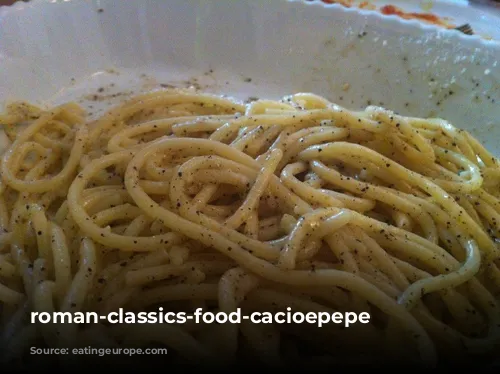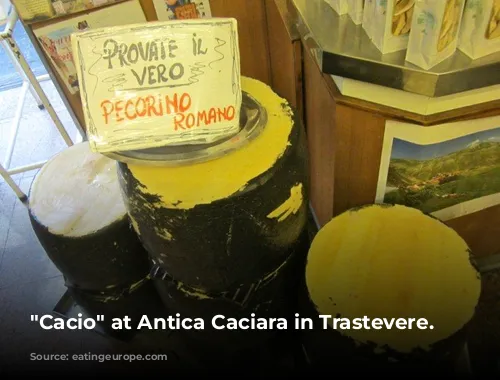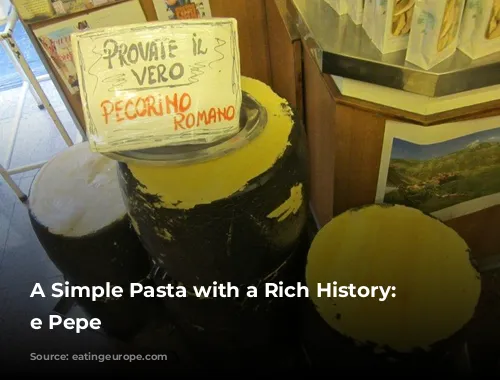Cacio e pepe – a name that might sound unfamiliar to some, but for those who have had the pleasure of tasting it, it is a Roman culinary treasure. This humble pasta dish has captured the hearts and stomachs of Romans for centuries, and it’s no surprise why. With just three ingredients: cheese, pepper, and pasta, it delivers a flavorful and satisfying experience.

A Tale of Three Ingredients
Cacio e pepe’s origins are as deep as the flavors it evokes. The cheese, pecorino, a sheep’s milk cheese, has been a staple in the Mediterranean region for millennia. Its history stretches back to Ancient Egypt, where evidence suggests it was enjoyed 3,000 years before Christ. The Romans, known for their culinary prowess, embraced pecorino, spreading its production throughout their vast empire.
Black pepper, the second star of the show, has also been a part of human history for ages. It was used by the Egyptians, as evidenced by its presence on the mummified remains of Ramses II. Around 2,500 years ago, pepper found its way to Greece and then to Rome, where it was valued as a precious spice and even used as currency. Its importance is highlighted in a historical anecdote where the Roman Empire appeased Alarico, the king of the Visigoths, with 5,000 pounds of gold, land, and 3,000 pounds of pepper to avoid an invasion.
Pasta, the final ingredient, is equally ancient. While the Chinese may have enjoyed rice spaghetti 4,000 years ago, Europe and the Middle East developed their own forms of pasta around the same time. The ancient Romans called it laganum, a dough made of water and flour, which was then kneaded and cut into strips, resembling the fettuccine we know today.

A Shepherd’s Delight: The Origins of Cacio e Pepe
The simple yet perfect combination of cacio e pepe is believed to have been perfected by shepherds who lived a nomadic life. Pecorino, pepper, and dried pasta were essential items in their travel bags. These ingredients, along with a bit of lard for their iron skillets, allowed them to create a complete and satisfying meal anywhere they went.
Cacio e pepe was a practical and nourishing choice for these shepherds:
- Pecorino’s durability made it ideal for long journeys.
- Pepper provided warmth during cold nights.
- Pasta offered the essential carbohydrates and calories to sustain them through their work.

A Timeless Classic: Resisting the Temptation of Change
Cacio e pepe, a testament to simplicity and tradition, has stood the test of time. While variations with other cheeses, oils, and pasta shapes exist, the original recipe remains the undisputed champion.
The true cacio e pepe experience calls for spaghetti number 5, ground black pepper, and grated Roman Pecorino DOP. A unique technique ensures the perfect marriage of flavors:
- While the spaghetti cooks, combine grated pecorino and pepper in a bowl.
- Remove the pasta from the boiling water with a spoon, preserving the starchy water.
- Toss the spaghetti with the cheese and pepper, adding two ladles of the pasta water.
- The hot water finishes cooking the pasta and evenly coats it with the cheese and pepper.
This simple yet precise process delivers a creamy and flavorful pasta dish that is truly a celebration of Roman cuisine.
The Perfect Pairing: Falesco – Poggio dei Gelsi – Est! Est! Est! di Montefiascone D
To elevate the cacio e pepe experience, a well-chosen wine is essential. A crisp and balanced white wine from Lazio complements the saltiness of the cheese and the spice of the pepper beautifully. Falesco – Poggio dei Gelsi – Est! Est! Est! di Montefiascone D is the ideal choice.
This wine, with its straw yellow color and hints of white flowers, ripe fruit, and a touch of minerality, delivers a harmonious and refreshing experience. Its smooth and persistent finish, with notes of plum and almond, creates a perfect harmony with the richness of cacio e pepe.
So, if you’re looking for a culinary adventure that will transport you to the heart of Roman cuisine, cacio e pepe is a must-try. Its simplicity, history, and unforgettable flavors are a testament to the enduring power of good food.
Are you ready to learn how to create this masterpiece yourself? Francesco, a top-class chef from the renowned Spirito DiVino restaurant, is waiting to share his expertise with you in our online experience!
